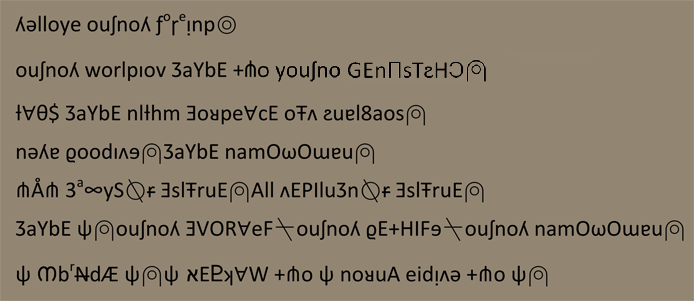|
|
||
All about lƎabElOur differentiated earthly languageThe creator self abides beyond the clouds over the Tower of Babel. Surely deep down we all remember the language we used to speak as we were building the Tower of Babel. A true creator is the master of contradictory elements yet undifferentiated into manifested world and so nowhere is truly his home but heavens. The creator self manifested Logos and so our vivid world was born. In our today “differentiated” language we incorporate uncountable dual concepts that are essential to the perceived world of diversified and contradictory parts - the world of knowledge of good and evil. In my opinion language today is not useful enough for expression and exchange of intent. Apart from the numerousness of languages and their boundary to time and place, languages are apt to provoke pre-justice, unbalance and uncertainty to a degree that sometimes they even stop serving their purpose of communicating knowledge. For example consider these so-called "informative" expression, each accompanied by a question challenging the instability of our differentiated language:
It should be noted that knowledge is also dual in nature and there exist many practical concepts not presentable by words - especially practical concepts. I think human beings are eager toward human communication - as an important feature of creation. And this feature has an important result of ensuring that their own species will survive through years and centuries. I guess in this communicational infrastructure the meaning has a second importance if any at all. e.g. in above example of “The sky is blue” nobody cares if the sky is blue or not and I think such expression is more interrogative or exclamatory than declarative a sentence. The speaker here may be a passenger trying to communicate to another stranger and he means “I like you. Let’s start talking!”. Or the speaker may be an astronomer proposing “The sky seems blue to me. Let’s investigate more”. And the speaker may be a poet implying “A vast blue thing like sky provokes my sensations deeply!” lƎabEl languageAs an artist I have spent a great deal of time expressing myself. And no doubt the way of the artist is the way of the creator. Means of expression are numerous. But the realm of words is a tricky one as I outlined by “The sky is blue” example earlier. To adopt the way of creator I decided to construct an undifferentiated language apposite for a creator. I called it lƎabEl (adj: lƎabElish). In this language I have tried to balance every word by its opposite and instead of "word", I introduced the concept of Brick - consisting of two fused opposites words into one word-compound. lƎabEl looks like this:
 Translation: hello/bye our/your friend/foe! ConceptslƎabEl: A constructed writing language, aiming to reconstruct the Tower of Babel by finding opposite concepts in harmony. The native language of Salim Ghazi Saeedi's world. lƎabElish: lƎabEl and lƎabElish represent the same concept since lƎabEl has no specific nation. lƎabEl people are the living words themselves - that are human beings. Brick: Word in lƎabEl language. A building block of the Tower of Babel benefiting lƎabEl users to accomplish the unfinished task. Each Brick is represents in its Base language a compound of two concepts (half-Bricks). e.g. ϱoodıʌɘ="good/evil". half-Brick: Represents an unbalanced concept, like good - that will be balanced by another half-brick, bad - into ϱoodıʌɘ Desire: Sentence in lƎabElish. A sequence of bricks (lƎabElish words) manifesting creator’s desire like “Sky/abyss maybe black/blue” Base language: The language which lƎabElish "Desire" is based upon. e.g. English or other languages. Rest: The desires are timeless. In between desires there is time for rest and breath taking. Rests are shown by specific symbols presented in dictionary. Equivalent for punctuation in English. Treasury: The summation of lƎabElish vocabulary. Psi (Ψ): The God abiding above the mythical Tower of Babel. Ψ is the Brick for "you/I" in lƎabElish. CharacteristicslƎabEl language incorporates one word (Brick) for each pair of opposite concept (half-Bricks). A word in lƎabEl vocabulary has the following characteristics:
Using letters from different languagesUsing letters from different
languages helps lƎabEl to serve its own purpose at its best - as it
evokes the spirit of different languages for presentation of one
meaning through a language the reader understands (Base
Language). It is ideal if the lƎabElish text is written trying through
hieroglyphs of the most diverse languages possible as Base languages.
Let's say attempting to
revive the Tower of Babel by the same means it became destroyed:
Language. |
(C) Salim Ghazi Saeedi 2010-2011
www.salimworld.com